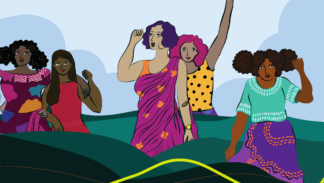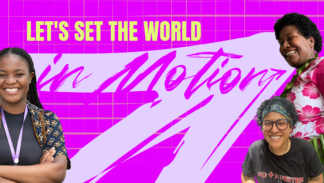Answering the million dollar question: Reflections on how to support fundraising in local contexts
Anjali Vogelsang
Fundraising is hard. Fundraising for women’s human rights can feel, at times, near impossible. With funding for women’s rights groups falling by more than half over the past five years, there is little doubt among anyone in the field that we—donors, grantee partners—need to do more to mobilize, raise resources, and influence funding. Just how we do that is the million dollar question.
One effort we made recently was to convene some of our grantee partners in Indonesia and the Philippines working on ending gender-based violence for a four-day training on organizational sustainability, which took place in Jakarta in April. Sessions were held on monitoring and evaluation, proposal writing, the fundraising landscape, common fundraising challenges, and, on the last day, action planning—specifically how each organization could apply what they have learned to improve their organizational sustainability.
The convening was a success primarily because it was grounded in peer learning. Global Fund for Women has had some success with fundraising, but we are not experts on the local fundraising landscape in Indonesia and the Philippines, nor in a position to give extensive fundraising advice for a landscape that is, in many respects, quite different from the one in which we operate. We knew that participants would be able to learn more from each other’s experiences than our own.
Our aim was to get organizations to think critically and creatively about fundraising. For example, in the proposal writing session, after going over some tips for writing a strong proposal and other essential best practices for developing a proposal, I asked participants to look at sections of a Global Fund for Women proposal and critique it based on what they had just learned. What did they like? What would they change? Would they fund it? This process made them realize that we are all very much in similar situations—no proposal starts out perfect. It requires a critical review and an objective set of eyes. After a brief second of hesitation, the feedback came: “There is too much jargon—you could simplify your message so it will be more easily understood by the donor”… “The sentences are too long”… “Is it really necessary to include all of this information in the Executive Summary?” The more I smiled and nodded, the more the feedback came. This was further reinforced when I asked participants to review proposals written by other participants and to provide feedback to them. This critical eye is important for developing a strong proposal and one that participants became more confident sharing.
During the session on the fundraising landscape, we asked organizations to write all of the prospective or current donors they knew, who they have successfully tried to get funding from, and who they have unsuccessfully tried to get funding from. In looking at the visual mapping of everyone’s input together, most organizations had only tried to get funding from international women’s funds like Global Fund for Women and Mama Cash. This sparked discussion among the group about whether they should be trying to more actively pursue other types of funders, like the local government or corporations, and what strategies they may need to use to be less reliant on one type of donor. The idea of small, targeted fundraising events came up a number of times, especially after one organization shared their successful fundraising event “Forget Your Ex” in which attendees (mostly younger adults) sold items belonging to their former partners. Amidst the roars of laughter and amusement from participants came the realization that these creative approaches were worth exploring further.
Will the convening lead to all of these organizations raising more money? Maybe not. There are so many variables outside of their control that will inform that answer, such as staffing capacity and fluctuating donor interest. Do participants feel more confident than before to tackle the challenges of fundraising, knowing that they are not alone in their efforts to do the seemingly impossible? Definitely.


